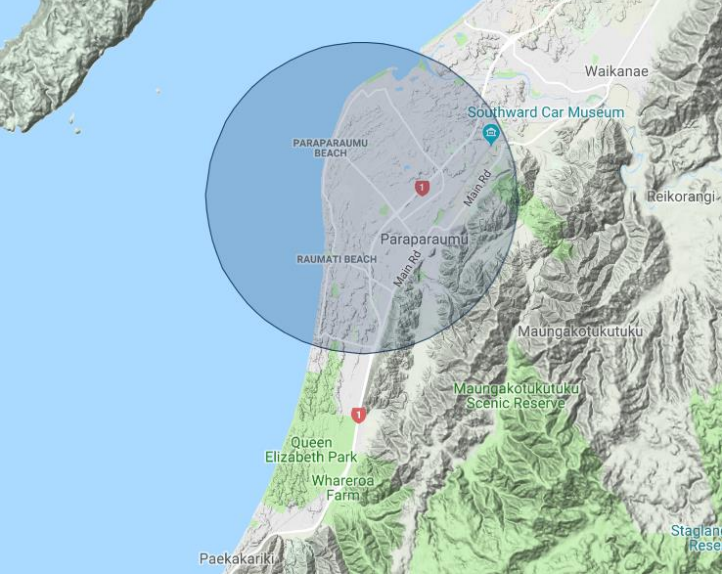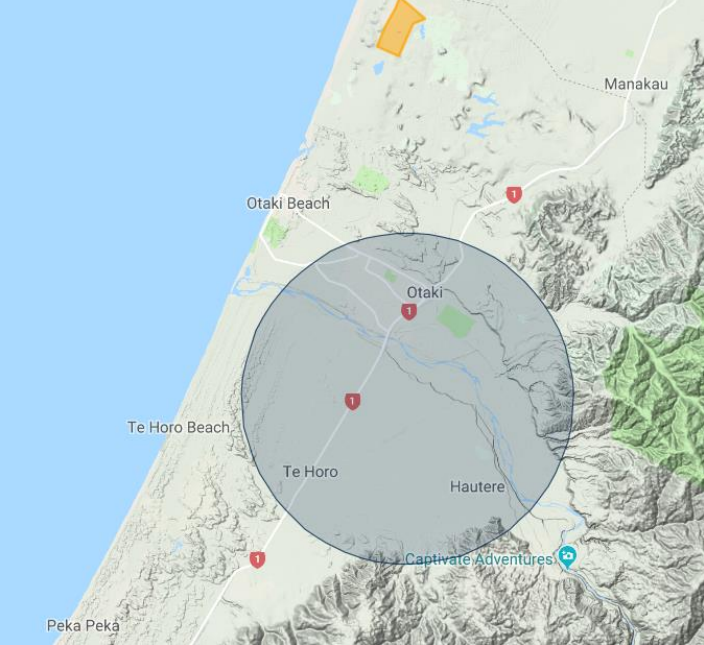Drones
Drones, or unmanned aircraft, are popular for fun and work. In Aotearoa New Zealand, drones are considered aircraft under the New Zealand Civil Aviation Authority (CAA) rules, so there are important rules to follow to keep everyone safe.

What they are
A drone, also known as an unmanned aerial vehicle (UAV), is a type of aircraft without a human pilot on board. They’re controlled either by computers inside the drone or by a person using a remote control.
What you need to know
The CAA makes the rules for flying drones. If you fly a drone, you need to know the rules and follow these, and any other relevant Council policy. Always check if the area you want to fly in is a controlled airspace.
Council rules
Council has rules for drones in our Public Places Bylaw. The sections you’ll need to read are:
- section 12.2
- section 15.1.
Also check our Beach Bylaw 2021, and Film Friendly Policy 2019, if they apply to your drone use.
No-fly zones
Blue circle – 4-kilometre radius around an aerodrome – no flying allowed.
Orange area – Low Flying Zone – no drones allowed.

Image: No-fly zone over Paraparaumu. See larger image [PNG 612 KB].

Image: No-fly zone over Ōtaki and Te Horo. See larger image [PNG 552 KB].
Flying drones in parks
To fly a drone over Council’s parks or reserves, you need permission from our Parks and Open Spaces team. You can do this by:
- emailing us
- completing a request for service
- calling us.
Otaraua Park
Otaraua Park is the only place in the Kāpiti Coast District where you can fly drones without applying for Council permission. It’s outside the 4-kilometre no-fly zone of an aerodrome, but there are power lines through the park. Keep your drone at least 50 metres away from these lines.
Otaraua Park rules
You must follow these rules at all times:
- New Zealand Civil Aviation’s rules, outlined at Know the rules.
- Don’t fly your drone when the sports fields are in use.
- Keep your drone within the “UAV Area” on the map.
- Keep away from the high voltage lines (outside the yellow and orange lines) at all times.
Drones don’t need direct contact with high voltage transmission assets for electricity to arc and cause loss of power, destroy the vehicle, or cause serious harm to people and property. - Do not try to retrieve your drone if it gets caught in a Transpower line or tower.
Call 0800 THE GRID (0800 843 4743). - Get permission from other park users if filming.
- Be polite, and keep your drone in sight at all times.
- Fly only during daylight.
- Stop flying immediately if asked by Council staff.
- Council will withdraw permission if you break these rules, or bother others.

Image: Otaraua Park, and the designated UAV/drone flying area there, as well as the no-fly area due to high voltage lines. See larger image [PNG 805 KB].
Flying over private property
Always get the property owner’s permission before flying over private property. Check the CAA’s rules and regulations for more information.
Flying at the beach
Follow the CAA’s rules and regulations, and any other Council policies when flying a drone at the beach. Drones can be used for long-line fishing under specific rules – see our Beach Bylaw.
Other areas
Check with the right agency for permission to fly over their land:
- Department of Conservation for conservation land
- Greater Wellington (GW) for GW parks (such as Queen Elizabeth Park).
Using drones for filming
To use a drone for filming, follow CAA’s rules and regulations. Your production company must provide:
- a production plan showing how you’ll follow CAA rules (Part 101 for drones under 25kg, Part 102 for drones over 25kg)
- CAA certification, as required
- health and safety plan
- an aviation clause in your Public Liability insurance
- permission from Kāpiti Coast Airport for flying within 4 kilometres of the airport
- permission from property owners.
See our Film Friendly Policy for more information.
Reporting problems
If you have a safety concern about drones, report it to the CAA.
For concerns about drones operating in Council’s public places, please call us.